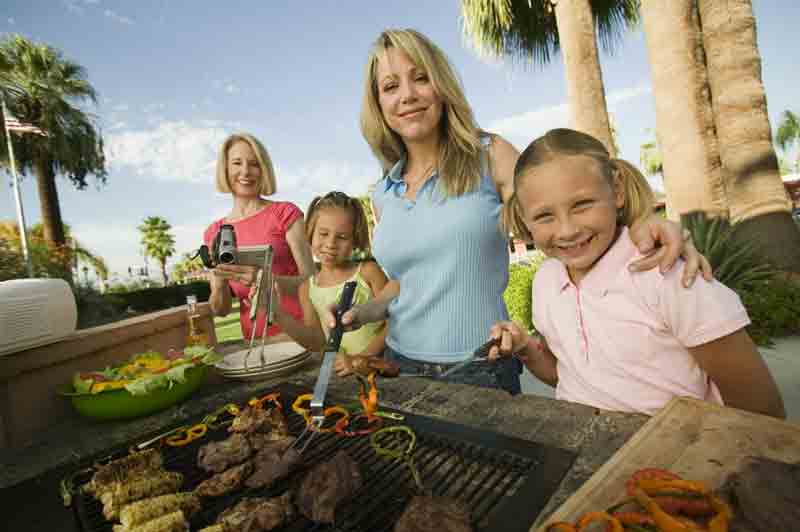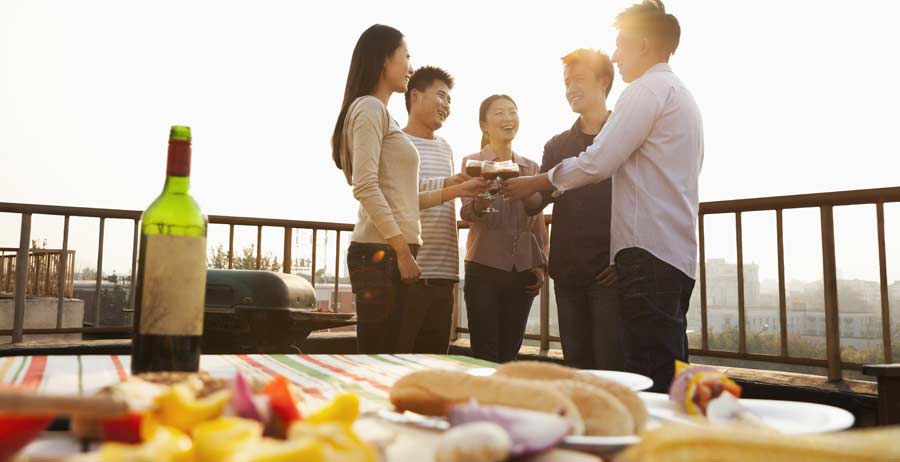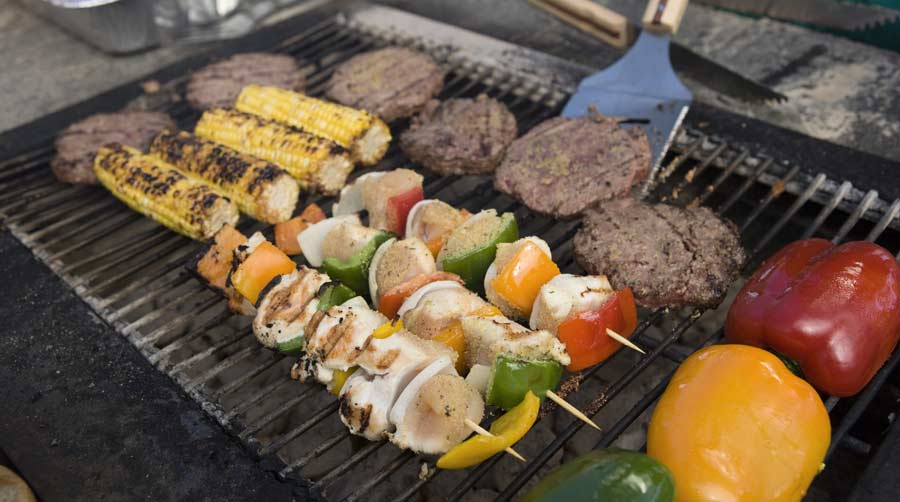
There aren’t many things better than enjoying a delicious barbecue on a warm summer’s day right?
You are dead right!
Follow our simple guide to learn how to barbecue the right way and cook up some delicious food everytime!
Barbecues are a popular part of many cultures across the world. They also usually signal the arrival of summer and warmer weather.
The good news is:
All you need to prepare a wonderful barbecue is some knowledge on how to operate the different types of grills and the temperature requirements for the food you wish to prepare.
The even better news is:
We are going tol provide you with all the information you need to prepare delicious barbecues for any occasion.
Types Of Barbecue Grills
Barbecue grills are generally grouped into four categories according to their heat source; gas, electric, pellet and charcoal.
Gas Grills
Gas grills are fueled by propane or natural gas. A rubber tube is used to connect the grill to an external gas source such as a portable gas tank or a domestic natural gas outlet.
Food can be cooked directly over the open burner. A gas valve is used to control the flow of gas into the burner and to regulate cooking temperatures.
This is handy:
Most modern gas grills are also fitted with a ‘smoke box’ where wood chips can be placed to give the meat a smoky flavor.
Advantages
- You can easily control the cooking temperature by adjusting the flow of gas using a knob.
- Working with a gas grill doesn’t require much experience as long as you understand how to adjust the temperature.
Disadvantage
- Gas grills tend to be more expensive compared to charcoal and electric grills.
Electric Grills
These grills use electric power to heat up the grill plates. They tend to be smaller in size and are therefore more portable than both charcoal and gas grills.
Advantages
- Electric grills can be used indoors because they produce less smoke than gas and charcoal grills.
- Such grills can come in handy in urban areas where strict fire safety laws prohibit the use of charcoal and gas grills.
Disadvantages
- Barbecues prepared using electric grills won’t have the distinctive smoky flavor that comes with using a traditional charcoal grill.
Pellet Grills
Pellet grills have been around for 30 years and are becoming more popular. Hardwood pellets burn in a fire pot beneath the grill – a fan creates a convection heat and ensure the food is cooked evenly.
Advantages
- Very versatile – you can cook in many ways – smoking, roasting, grilling braising and more
- You can get a variety of flavored pellets – all add their own unique taste to food and can be changed easily
- Because it works with a convection heat – food is always evenly cooked
Disadvantages
- They are reasonably expensive compared to other grills
- They need electricity to run, so you will always need to be near a power point.
Charcoal Grills
Charcoal grills use charcoal briquettes as fuel. Some types of charcoal grills have modifications that allow the usage of hardwood pellets and sawdust as well.
Advantages
- The smoke coming from the burning charcoal will add a pleasant smoky flavor to whatever is being cooked.
- Charcoal grills are usually cheaper than gas and electric barbecue grills.
Disadvantages
- Lighting up a charcoal grill takes a lot of time.
- Burning charcoal produces a lot of ash. This complicates the cleaning process for these types of grills, especially when the ash gets mixed up with the oils dripping from the food being cooked.
- Charcoal grills don’t have temperature control knobs. Your food could easily get overcooked due to overheating. Knowing how to maintain a constant cooking temperature by controlling airflow and regulating the quantity of fuel is a skill that takes time to develop.

Getting Started
The most commonly barbecued foods tend to be meat-based products such as beef chops, pork, chicken, sausages and fish.
However, you can also prepare a wide variety of vegetables, cereals and so much more using your barbecue grill.
You can find several interesting barbecue recipes on the internet.
So let’s get started…
What You Will Need
- Fuel for your grill
- Grill gloves
- Metallic barbecue spatula
- A pair of tongs
- Aluminum foil
- Meat thermometer
- A fire extinguisher
- A wire brush to clean the grill
- Spices and condiments: Salt, pepper, mayonnaise, ketchup
- A chimney lighter (to light up a charcoal/pellet grill)
Preparing Your Grill
Find an open area in your backyard to place your grill. The ideal spot should be well-ventilated and far away from anything that could easily catch fire. If you are going to use an electric grill, make sure that you have an easily accessible power outlet nearby.
Empty any ashes from your grill and use the wire brush to scrub off food particles and grease from the cooking grate.
Connect your grill to the electric or gas outlet and turn it on. If you are using a charcoal grill, use a chimney lighter to ignite the charcoal briquettes or pellets.
This is important:
Never use liquid fuel to light up your charcoal grill. Liquid fuels produce unpleasant fumes as they burn and this can ruin the taste of your food.
Let the grill heat up for at least 20 minutes before you start cooking your food. As the grill gets heated up, spray some cooking oil on the cooking grates to prevent food from sticking to the grill when you start cooking.
Stand a few feet away from the grill when spraying the cooking oil to avoid any accidental injuries from flare-ups that may happen when the oil comes into contact with the naked flame.
Direct vs Indirect Heat Grilling
You can grill your food using either the direct or indirect heat techniques.
The ideal grilling technique to use will depend on the type of food you want to prepare and the result you wish to achieve with the ood you are cooking e.g medium rare or thoroughly cooked.
In direct grilling, food is cooked using direct heat and opening the lid if your grill has one.
It is pretty simple:
In gas and electric grills, this is usually done by turning up the heat to the highest temperature setting. In charcoal grills, this involves placing the food directly above the burning charcoal.
This method is ideal for foods that require less than 30 minutes of cooking such as sausages, hamburgers, fillets, thin meat cuts and vegetables.
On the other hand:
In indirect grilling, food is cooked slowly under medium or low temperatures for extended periods of time (over 30 minutes).
In gas and electric grills, this involves setting the cooking temperature anywhere between 250 to 350F.
If you are using a charcoal grill, you will need to push the burning lumps of coal to one side of the grill. You can then place your food over the other half of the grill that has no charcoal burning underneath.
You must remember:
This method will only be effective when the lid is closed.
This will help you achieve uniform heat distribution. Indirect grilling can be used for large pieces of meat, steaks and fish which need more time to cook.

How To Grill Meat
Let’s get down to the meat and bones of it (sorry!). How to cook meat on a barbecue:
Without further ado:
- Season your meat by adding some salt and pepper or any other spices. You can also apply a little cooking oil if the meat is too dry, but don’t add too much. This should be done at least one hour before you start cooking to allow the meat to take in the seasoning.
- Light up the grill after you have seasoned your meat and let it heat up nicely for at least 20 minutes.
- Place the meat on the cooking grates to start cooking. For large chunks/slices of steak that are more than one inch thick, place them in direct heat until they turn brown before using the indirect grilling method described above. This will help to ‘seal in’ the juices in the meat to preserve the flavor.
- Burgers, hot dogs and thin slices of meat can be coked using the direct heat method since they require less cooking time.
- You can insert a meat thermometer into the thickest part of your steaks to monitor the temperature as they cook.
For most types of meat, the outer part will cook faster than the inside. You can slice through the thickest part of the meat using a knife to check if the inner part is ready. - Always use a spatula to turn the meat over. Using a fork will puncture the meat and cause it to lose some of its juice.
And boom! You are there.
How To Grill Vegetables
Believe it or not:
You can also include some fruits and vegetables in your barbecue to add variety.
Vegetables should be cooked in moderate to low temperatures of between 250 to 350F. They also cook much faster compared to meat.
- Cut the vegetables into smaller pieces before applying some cooking oil, salt or any other seasoning.
- Since most vegetables tend to be small in size, they will easily pass through the cooking grates if you try to place them directly on the grill. You can place them on skewers or inside a stainless steel cooking basket before cooking.
Alternatively, you could wrap them in aluminum foil first before placing them on the grill. - Cook the vegetables in medium heat using the indirect heat method described above. Vegetables will generally take between 10 to 15 minutes to cook.
Safety Tips
Obviously using a barbecue can be potential hazardous, so:
- Ensure that your grill is positioned at least ten feet away from any objects or free-standing structures that could easily catch fire.
- Always ensure that you maintain a distance of at least two feet from the grill when cooking. This will keep you safe from sudden flare-ups that usually occur when oil from the food comes into contact with naked flames.
- Always have a fire extinguisher close by to help you put out any fire in case things get out of hand.
And there we have it – a short guide to help you barbecue the right way. I hope you can produce some delicious food!
USEFUL RESOURCES
Want to learn more about barbecuing? You can find further information here:
- All-Time Top 10 BBQ Tips – Jamie Oliver
- A Beginner’s Guide To The Barbecue – Start Cooking
- How To Cook Meat Properly On The Barbecue – BBC Good Food

